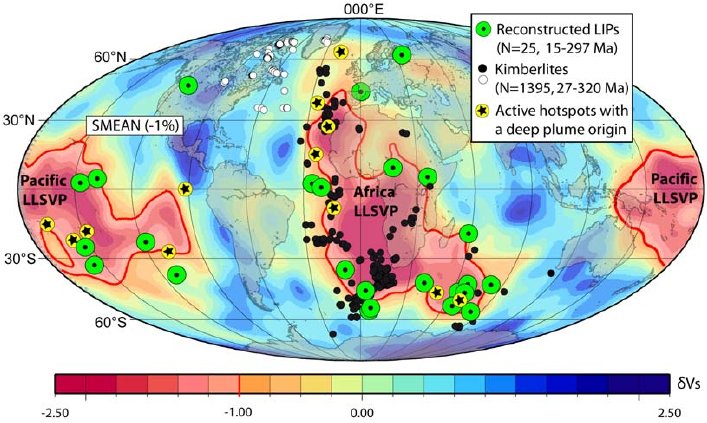A glance into the history of the Earth with high economical potential
15.07.2010 | Potsdam: The source of diamonds is closely linked with processes, which take place deep in the Earth’s interior, at the core-mantle boundary at depths of approximately 2900 kilometres. The same procedures, which led to the formation of Large Igneous Provinces (LIPs), also sculpted the areas in the cores of the continents, in which today the richest diamond deposits of the world are found. That is a result of the investigation of Kimberlite rocks, presented by a group of scientists from Norway, South Africa, Germany and the USA in the latest volume of “Nature”.
Kimberlite is a rock of magmatic origin, which can contain diamonds. It originates from a depth of more than 150 kilometres and is found at the Earth's surface in the continent cores, the so-called cratons. Due to plate tectonics the edges of continents are continuously being altered, and even former supercontinents such as Gondwana can break apart; the cores of the continents, however, have been shaped particularly by masses of hot rock, which formed over hundreds of millions of years at the core-mantle boundary and rose to the surface as so-called “plumes”. There they could flood enormous areas with hot liquid lava; in the thick cores of the continents, however, they could lead to the formation of diamond-rich Kimberlites.
With a model of the absolute plate movements, the scientists were able to reconstruct the original position of the continents and, thus, the positions at which Kimberlite was formed in the old cratons. They found out that these areas are mainly located at the borders of large areas in the Earth's lowermost mantle, in which seismic shear waves spread considerably slower. (Large Low Shear Velocity Provinces, LLSVPs).
It is expected that these areas of the seismic anomalies consist of chemically different and heavier material, for example with a higher iron content. On the basis of their higher weight they remain in the lowest mantle, being, however, hotter than the remaining mantle. It is a model concept that rock material flows along the core-mantle boundary heating up by means of warmth from Earth's much hotter core. If this material then meets with regions of higher temperature and also higher density, it is diverted upward. Thus, a thicker layer of hot mantle material forms. This leads to thermal instabilities, which then rise in the form of plumes through the entire mantle. These plumes lead to volcanism, with its magma pouring over the Earth's surface; their heat energy, in turn, leads to the formation of Kimberlites.
Due to this connection, it can, thus, be shown for the first time that plate tectonic reconstructions within the framework of the Earth's mantle can possible be of economic significance.
“Diamonds sampled by plumes from the core-mantle boundary” Trond H. Torsvik, Kevin Burke, Bernhard Steinberger, Susan J. Webb, Lewis D. Ashwal Nature, No., pp.








![[Translate to English:] Torsten Sachs in front of a climate station on a field](/fileadmin/_processed_/3/9/csm__TorstenSachs_bearbeitet_GS_4a1365ef84.jpeg)

![[Translate to English:] left image flood at the Ahrtal: image from above, several houses are flooded; left image:: Heidi Kreibich;](/fileadmin/_processed_/4/4/csm_Bild2_9af0130e9f.png)



![[Translate to English:] Start der Vega Rakete](/fileadmin/_processed_/6/4/csm_20231201-kachel_Vega-VV23-launch_ESA-CNES-Arianespace_706716b68c.jpeg)









![[Translate to English:] Poster exhibition at the Brandenburg Hydrogen Day at the GFZ, some participants in the foreground](/fileadmin/_processed_/6/5/csm_Erster_Brandenburgischer_Wasserstofftag_GFZ_402fcec95e.jpeg)
![[Translate to English:] Group picture of the participants](/fileadmin/_processed_/9/4/csm_20231108_CAWa-Workshop-Tashkent_Gruppenbild_99ea779d8a.jpeg)

![[Translate to English:] [Translate to English:] Hörsaal](/fileadmin/_processed_/e/6/csm_H%C3%B6rsal_e21ac645fb.jpeg)


![[Translate to English:] The Delegations in the Historic Library on the Telegrafenberg. In the back there are from left to right, the Dutch Ambassador for Germany, Ronald van Roeden, the Dutch Minister for Education, Culture and Science, Robbert Dijkgraaf and the scientific director of the GFZ, Susanne Buiter.](/fileadmin/_processed_/d/b/csm_Kachel-2_9eba4b4212.jpeg)

